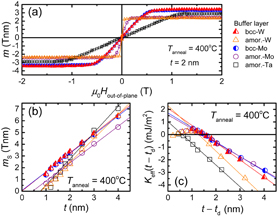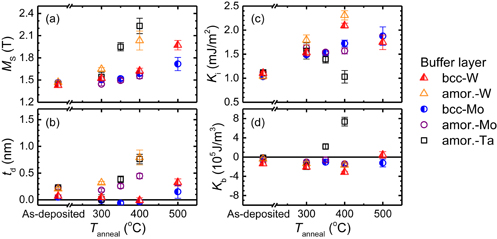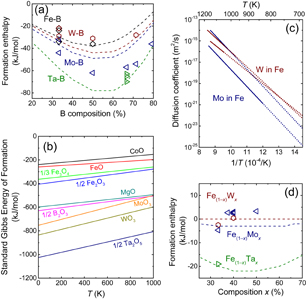Abstract
We investigate the annealing temperature dependence of the magnetic properties of CoFeB/MgO stacks with different buffer materials (Mo, Ta, and W). For Mo and W, bcc-crystalline and amorphous-like films are prepared by changing the deposition conditions. A relatively small saturation magnetization is maintained after annealing up to 400 °C for the samples with bcc-W, bcc-Mo, and amorphous-like Mo buffers. A small variation in magnetic dead layer thickness with annealing is observed for the samples with bcc-crystalline buffer layers. The interfacial anisotropy is found to mainly depend on the element of the buffer layer used regardless of its crystalline structure, and is larger for the samples with W and Mo buffers than those with Ta buffer. The sample with bcc-Mo buffer shows the highest robustness against annealing among the studied systems. We give a systematic picture based on the thermochemistry that can reasonably explain the observed buffer layer dependence of the variations in magnetic properties with annealing.
Export citation and abstract BibTeX RIS
1. Introduction
CoFeB/MgO is a prime candidate for the material of magnetic tunnel junction (MTJ) devices in spin-transfer torque magnetoresistive random access memory (STT-MRAM) and spintronics-based VLSIs,1–8) owing to the high tunnel magnetoresistance (TMR) ratio and large interfacial perpendicular magnetic anisotropy.9–12) There has also been an increasing attention on trilayer systems with heavy metal/CoFeB/MgO for spin–orbit torque (SOT)-MRAM.13–16) Magnetic properties of CoFeB/MgO stacks are known to vary with various parameters such as the deposition conditions of CoFeB and MgO,17–19) the B composition in CoFeB,20–22) the adjacent layer material,23–31) the thicknesses of CoFeB, MgO, and adjacent layers,32,33) and the annealing temperature/duration.33–35) We have recently reported that the properties depend not only on the element of the adjacent layer but also on its crystallographic structure, using Mo and Ta buffer layers.36) For practical use, it is of particular importance to maintain good magnetic properties after annealing at 400 °C, which is a standard requirement in back-end-of-line processes in semiconductor-integrated-circuit fabrication. Several recent studies pointed out that W and Mo have a favorable annealing-tolerant characteristic and thus are promising for the adjacent layer material of CoFeB.37–40) It was also shown that W/CoFeB/MgO with metastable β-phase (or amorphous-like) W with high resistivity is a promising system for the SOT-MRAM owing to its high spin Hall conductivity.41–44) However, the underlying mechanism for the dependence of magnetic properties of CoFeB/MgO stacks on the annealing temperature and buffer layer material is yet to be elucidated. In this report, we show a systematic study on the annealing temperature dependence of the magnetic properties of CoFeB/MgO with five kinds of buffer layer, bcc/amorphous-like W, bcc/amorphous-like Mo, and amorphous-like Ta. From the obtained results, we discuss the mechanism that governs the variations in magnetic properties with annealing for stacks with various buffer layers.
2. Experimental methods
CoFeB/MgO stacks with various buffer layers with the thickness of 5 nm are deposited by dc/rf magnetron sputtering onto thermally oxidized Si substrates, with a 1-nm-thick Ta capping layer. Different crystallographic structures of Mo and W, bcc or amorphous-like, are selectively formed by tuning the sputtering conditions such as the sputtering power and inert gas pressure.36,43) Ta has an amorphous-like structure independent of the conditions. The thickness t of CoFeB is varied from 1 to 4 nm in order to quantify several magnetic parameters from the thickness dependence.11,36) Some of the samples are postannealed in vacuum for one hour in the temperature Tanneal range from 300 to 500 °C. Magnetization curves are measured using a vibrating sample magnetometer, and the magnetic moment per unit area m is measured by sweeping the magnetic field μ0H (μ0 is the permeability in free space) up to 2 T along the in-plane and out-of-plane directions [Fig. 1(a)]. Figure 1(b) shows the CoFeB thickness t dependence of the magnetic moment per unit area at the saturation mS for the samples with each buffer layer. Since mS is expressed as MS(t − td), where MS is the saturation magnetization and td is the magnetic dead layer thickness in CoFeB, we evaluate MS from the slope and td from the horizontal intercept by fitting with a linear fuction. The areal effective magnetic anisotropy energy density Keff(t − td) is evaluated from the difference between the in-plane and out-of-plane m-H curves. The magnetically active CoFeB thickness t − td dependence of Keff(t − td) is shown in Fig. 1(c). As the areal effective anisotropy energy density is expressed as  , where Kb is the bulk magnetic anisotropy energy density and Ki the interfacial magnetic anisotropy energy density, one can evaluate Ki from the intercept on the vertical axis of the linear fit and Kb from its slope. We evaluate MS, td, Ki, and Kb for the samples with different buffer layers annealed at various temperatures.
, where Kb is the bulk magnetic anisotropy energy density and Ki the interfacial magnetic anisotropy energy density, one can evaluate Ki from the intercept on the vertical axis of the linear fit and Kb from its slope. We evaluate MS, td, Ki, and Kb for the samples with different buffer layers annealed at various temperatures.
Fig. 1. (a) Magnetization curves along the out-of-plane direction for different buffer layers. (b) Magnetic moment per unit area at the saturation mS versus nominal thickness t, and (c) areal effective magnetic anisotropy energy density Keff(t − td) versus magnetically active CoFeB thickness t − td, for stacks with each buffer layer. Solid lines in (b) and (c) are linear fittings.
Download figure:
Standard image High-resolution image3. Results and discussion
Figure 2(a) shows the annealing temperature Tanneal dependence of MS. For Tanneal ≤ 400 °C, the MS of stacks with amorphous-like W and Ta increases more rapidly with increasing Tanneal than that with bcc W, bcc Mo, and amorphous-like Mo. Figure 2(b) shows the Tanneal dependence of td. The td for the samples with bcc buffer is nearly zero and constant with Tanneal within experimental errors up to 400 °C, while td for those with amorphous-like buffers increases with increasing Tanneal. Small variations in MS and td for the samples with bcc buffer appear to be favorable for fabrication-process-independent magnetic properties as well as long-term usage. In addition, a small MS results in a small demagnetizing field, which is also preferable for a large effective perpendicular magnetic anisotropy. It is known that the magnitude of MS is mainly determined by the B composition of the CoFeB layer, which is reduced through absorption by the adjacent layer during annealing.21,45–48) It is also known that td is determined by the degrees of the diffusion and intermixing of buffer layer atoms with the CoFeB layer.
Fig. 2. Annealing temperature Tanneal dependences of (a) saturation magnetization MS, (b) magnetic dead layer thickness in CoFeB td, (c) interfacial magnetic anisotropy Ki, and (d) bulk magnetic anisotropy energy density Kb.
Download figure:
Standard image High-resolution imageFigures 2(c) and 2(d) show the annealing temperature dependences of Ki and Kb, respectively. The magnitude of Ki in the as-deposited state is virtually independent of the buffer material. It increases more rapidly for the samples with W buffer regardless of its crystallographic structure than those with Mo and Ta buffers, probably reflecting the different degrees of intermixing between CoFeB and buffer layers as well as the interfacial anisotropy at the CoFeB/W interface.49–51) This is supported by previous studies, which indicate a twofold larger Ki at the W/Fe interface than at the Mo/Fe interface,52,53) and an enhanced anisotropy for the MgO/CoFeB/W/CoFeB/W structure.54) It is interesting to note that a different Ki behavior is observed for the amorphous-like W and amorphous-like Ta samples, although almost the same degree of interdiffusion is suggested from td, which will be discussed later. As for Kb shown in Fig. 2(d), only the sample with the amorphous-like Ta buffer layer shows a sizable variation with Tanneal, which may be related to the bond-orientation anisotropy due to the displacement of atoms by annealing.36,55–57) The bulk anisotropy Kb of the order of 105 J/m3 in the studied samples is not dominant for the total Keff.
The results obtained at Tanneal ≤ 400 °C indicate that the samples with bcc Mo and W show preferable properties such as a small MS, an almost constant td with an increase in Tanneal, and a higher Ki. To accentuate the difference, we further investigate their properties after annealing at Tanneal = 500 °C. MS, td, Ki, and Kb are plotted in Figs. 2(a)–2(d), respectively. At this stage, the properties of the bcc-W/CoFeB/MgO structure degrade to some extent; MS and td increase and Ki decreases, whereas the bcc-Mo/CoFeB/MgO structure almost keeps the properties. Thus, the bcc-crystalline Mo can be regarded as the most suitable buffer layer material for the CoFeB/MgO stack in terms of robustness against annealing.
From the obtained results, we can infer the following picture for the behavior of each element through annealing. For amorphous-like Ta samples, an increase in MS with annealing suggests a significant degree of absorption of B by the Ta buffer layer, a reduction in Ki suggests the migration of diffused Ta atoms resulting in the formation of bonds with O atoms in MgO, and a relatively large Kb suggests the bonding of Fe and Co atoms with the diffused Ta atoms. In contrast, for bcc-Mo and bcc-W samples, stable MS and td, and increasing Ki suggest that diffusion and chemical reactions are unlikely to occur. The more stable properties of bcc-Mo samples after 500 °C annealing suggest that degree of diffusion of Mo atoms is lower than that of W atoms. The increasing td observed for all the amorphous-like-buffer samples suggests that the atoms in the amorphous-like structure are more diffusive than those in the crystalline structure. In the following, we discuss the underlying mechanism causing these behaviors by considering the reported thermochemical characteristics relevant to the present systems.
Figure 3(a) shows the formation enthalpy of boride for Fe, Mo, W, and Ta,58) which affects MS through the B absorption by the buffer layer. A large negative formation enthalpy for Ta–B is consistent with the observed highest MS for the amorphous-like Ta samples shown in Fig. 2(a). The reason for the increasing MS observed for amorphous-like W samples has not yet been clarified, but it may suggest that interstitial absorption and/or diffusion along the fine-grain boundaries occur. The difference in the behavior of td between the crystalline and amorphous-like buffer samples shown in Fig. 2(b) can be understood by considering the morphological stability of the bcc-crystalline or amorphous-like buffer layer, as reported in Ref. 49. The Tanneal dependence of Ki, particularly the decrease in Ki for the Ta samples shown in Fig. 2(c), can be qualitatively explained by considering the Ellingham diagram shown in Fig. 3(b).59) It can be seen that Ta oxide is the most easily formed among the possible oxides including MgO. This is in line with our inference that at a high Tanneal some of the diffused Ta atoms bond with O atoms, where at low Tanneal O atoms mainly bonded with Fe and Co atoms inducing interfacial anisotropy.48,60–62) This perspective is also consistent with a previous study using a Hf buffer,26,37) whose oxide has almost the same Gibbs energy as Ta oxide. It was reported in Ref. 37 that the perpendicular magnetic anisotropy of Hf/CoFeB/MgO degrades with increasing Tanneal. The difference between the bcc-Mo and bcc-W samples observed after 500 °C annealing is consistent with the findings that W atoms are more diffusive than Mo atoms as shown in Fig. 3(c),63,64) and that W oxide has a slightly larger gain in formation energy than Mo oxide, as shown in Fig. 3(b).59) Finally, the sizable Kb observed only for Ta samples, which may be related to the bond-orientation anisotropy, is supported by the larger negative formation enthalpy of the Fe-Ta bond than of the other alloy systems as shown in Fig. 3(d). In such ways, the thermochemical consideration reasonably explains the observed difference in the Tanneal dependence of the magnetic properties among the samples with different buffer layers. Thus, it can be concluded that the buffer layer material should have a small negative formation enthalpy of boride, a stable crystalline structure, a small negative Gibbs energy for the formation of oxide, and a small diffusion coefficient in the CoFeB matrix. In this regard, FeTa and FeZr alloys29,30) may be a promising candidate for the buffer layer material of CoFeB because they have a lower formation enthalpy and are more stable than pure Ta or Zr.
Fig. 3. (a) Experimental (plots) and calculated (dashed lines) formation enthalpies of borides.58) (b) Ellingham diagram for several metal oxides. Values are normalized per mole of each metal.59) (c) Diffusion coefficient D values of Mo and W in Fe matrix.63,64) Dotted lines are the extrapolation results obtained from D = D0 exp(−Q/kBT); D0: frequency factor, Q: activation energy, and kB: the Boltzmann constant. (d) Experimental (plots) and calculated (dashed lines) formation enthalpies of iron-based intermetallic alloys.58)
Download figure:
Standard image High-resolution image4. Conclusions
We have investigated the Tanneal dependence of the magnetic properties of CoFeB/MgO stacks with five kinds of buffer layer, bcc/amorphous-like W, bcc/amorphous-like Mo, and amorphous-like Ta. A relatively small MS after annealing up to Tanneal = 400 °C is obtained for the samples with bcc W, bcc Mo and amorphous-like Mo. A magnetic dead layer is hardly formed for the crystalline buffer samples regardless of the element. On the other hand, the variation in Ki with annealing mainly depends on the element of the buffer layer regardless of the crystalline structure, and it is found that W and Mo samples tend to achieve high Ki values. After the films are annealed at 500 °C, the samples with bcc Mo are found to have the most stable properties. These results can be reasonably explained by a thermochemical consideration. The obtained insights are expected to be useful for designing the stack structure of a CoFeB/MgO based MTJ with a high annealing robustness.
Acknowledgments
The authors thank C. Igarashi, T. Hirata, H. Iwanuma, Y. Kawato, and K. Goto for technical support. This work was partially supported by the Research and Development Project of the ICT Key Technology of the Ministry of Education, Culture, Sports, Science and Technology, and by the ImPACT Program of the Council for Science, Technology and Innovation. K. Watanabe acknowledges the Graduate Program in Spintronics of Tohoku University.




